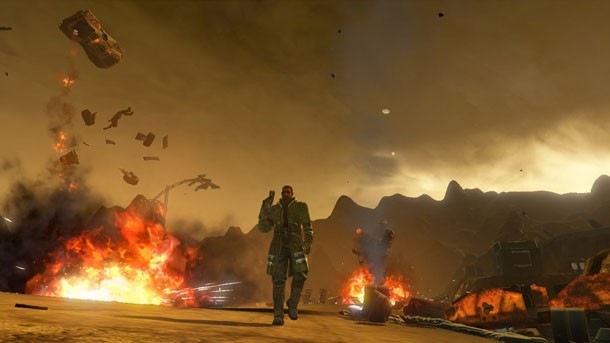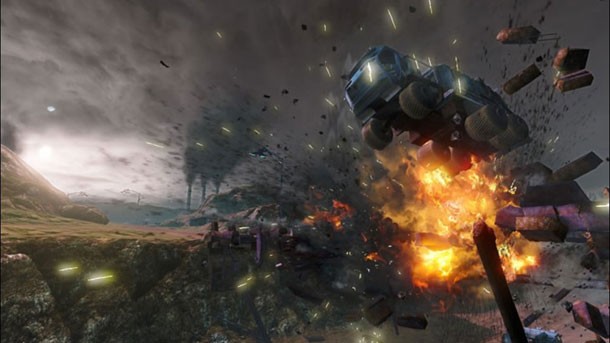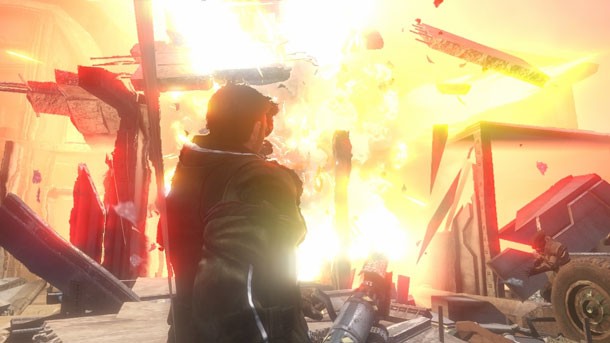Exploring Freedom In Red Faction: Guerrilla

Plenty of open-world games have given me the ability to run wild, from the fantasy and post-apocalyptic lands of Bethesda's Elder Scrolls and Fallout series, to Grand Theft Auto's bustling cities. However, no action game has given me more of a sense of freedom than Volition's technical marvel, Red Faction: Guerrilla, making it an easy pick for my July 4th selection.
Blowing stuff up has always been a staple of video games. Despite the relative and completely understandable rarity of explosives in the real world, rocket launchers, C4, and an endless suite of creatively themed grenades and mines are all standard issue in action games, to the point where even random digital mopes off the street can walk into their local Ammu-Nation and arm themselves to the teeth.
The average campaign in an action game contains enough explosions to make a Michael Bay film look like CSPAN, but despite this love of destruction, most games are surprisingly lousy at presenting it to players in a meaningful way. Blasts of fire and smoke regularly dissipate to reveal little more than black smudge marks on the environment that would be no match for a super villain equipped with a decent floor buffer. Real destruction is reserved for specific objects – your piles of crates and unattended red barrels – or are handled through scripted set-piece moments. Even more free-form mayhem is usually faked; destructible objects often won't respond to damage until they reach a hidden numeric threshold, then crumble in the exact way the developer animated it to. The result is still enjoyable, but strangely hollow – like you're the star soldier in your own Truman Show-style warzone.

But not in Red Faction: Guerrilla. In what is still one of the most impressive physics simulations of any game, all of the buildings and structures in the game could be realistically razed to the surface of Mars at your choosing. Launch a rocket at the side of the building, and the wall breaks apart where the projectile hits, exposing rebar as broken chunks of concrete fall to the ground. Blow up enough walls and the entire building will tip and come crashing down based on its structural weaknesses. It's still just as remarkable today as it was in 2009.
Players don't need much of a reason to blow things up in a game, but Red Faction: Guerrilla's destruction fit with its (admittedly underwhelming) story. As the title implies, you are part of a small and desperate resistance group, striking back against your evil corporate overlords, the Earth Defense Force (no, not that Earth Defense Force). It's up to you to decide when and where to attack, however, and the genuine destructive capabilities at your disposal offered an unparalleled feeling of control and power.
Destruction is such an important part of Red Faction: Guerrilla's gameplay that, despite attaining an arsenal of crazy sci-fi weaponry, your most valuable tool is still your trusty sledgehammer. Walking into an enemy installation and tearing it down piece by piece never got old, and Volition put a lot of care into ensuring each swing was satisfying. Eventually, you'd hear the telltale creak of the foundation giving way, which was your cue to make a mad dash to the nearest exit – or make a new one – to watch everything come crashing down from (hopefully) a safe distance. Blowing stuff up in Red Faction: Guerrilla's open-world sandbox was like playing with block towers as a kid again, and not having any adults tell you how you can knock them down.

When I first played Red Faction: Guerrilla, I remember thinking that finally a developer had delivered on the promise of next-gen gaming. I was excited not only for a sequel (which ended up being the linear and claustrophobic Red Faction: Armageddon), but also the wave of destruction-focused copycats it would spawn – maybe the next installment of Volition's own Saints Row series, or the next Battlefield or Call of Duty would up the ante.
Since then, our next-gen systems became last-gen systems, and our new consoles have seen a huge surge in the number of open-world sandbox games being developed for them. And yet none of them have even attempted to offer the kind of destructive freedom that Red Faction: Guerrilla delivered. Turns out that kind of advanced physics simulation is hard to create, much less design around. It's also what makes Red Faction: Guerrilla a one-of-a-kind gaming experience that's still fun today.

Get the Game Informer Print Edition!
Explore your favorite games in premium print format, delivered to your door.
- 10 issues per year
- Only $4.80 per issue
- Full digital magazine archive access
- Since 1991









